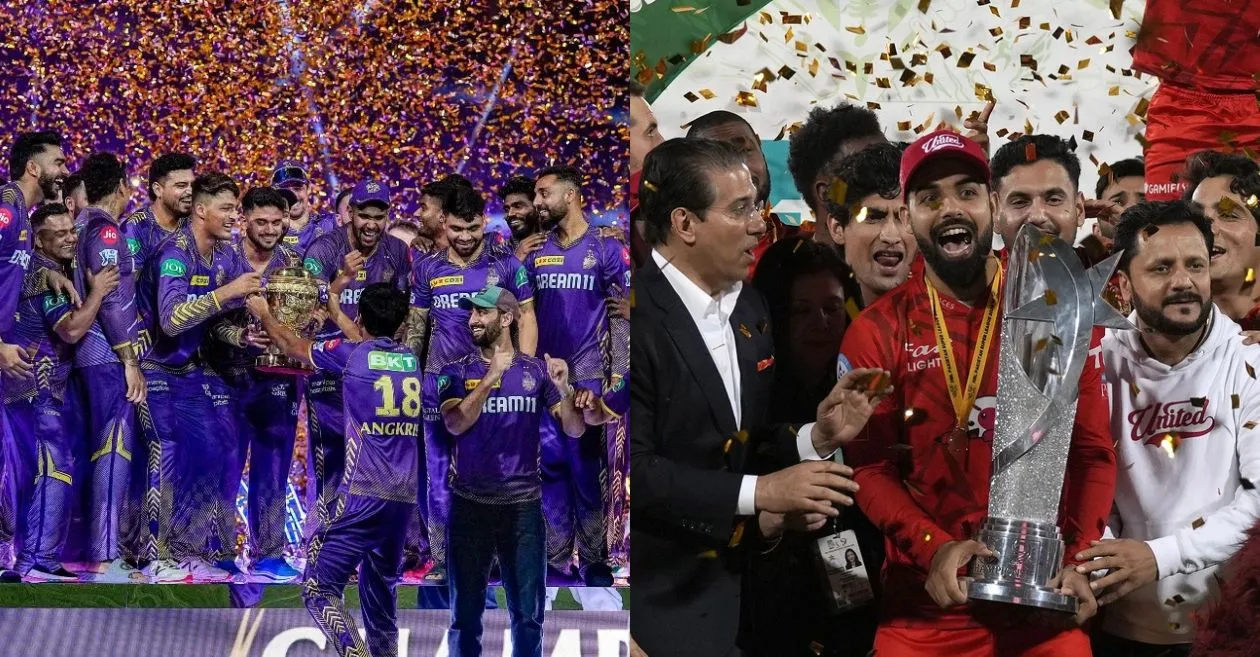Cricket has evolved significantly over the past two decades, and T20 leagues have played a massive role in this transformation. Among the many T20 competitions around the world, two stand out for their passionate following and impact—the Indian Premier League (IPL) and the Pakistan Super League (PSL).
Both leagues have developed their own identity, featuring world-class players, high-intensity matches, and a strong fan base. However, when it comes to financial power, prize money, revenue generation, and global reach, the gap between IPL and PSL is enormous.
A major indicator of this divide is the prize money awarded to the winners—a clear reflection of the financial scale and business models of the two leagues. While IPL champions take home ₹20 crore, PSL winners receive just ₹4.13 crore—almost five times less. This stark difference in financial rewards highlights the contrasting economic structures of the leagues and their standing in global cricket.
Let’s take a deep dive into the financial disparity, viewership, and overall business models of IPL and PSL to understand why IPL continues to be the undisputed king of T20 leagues.
📜 A Tale of Two Leagues: IPL vs PSL
🔹 IPL: The Financial Powerhouse of T20 Cricket
Established in 2008, the Indian Premier League (IPL) revolutionized the way cricket was played, watched, and marketed. With its city-based franchise model, star-studded teams, and intense rivalries, IPL quickly became a global sporting phenomenon.
Key factors behind IPL’s financial dominance:
✅ Huge broadcasting deals worth billions
✅ Big-money sponsorships from global brands
✅ Massive player salaries due to an open auction system
✅ High ticket sales and merchandise revenue
✅ Strong presence of international superstars
The impact of IPL’s financial strength is evident in the prize money awarded to the winners. Since 2018, IPL champions have consistently received ₹20 crore, with the runners-up taking home ₹13 crore. Even the teams finishing third and fourth place get ₹7 crore and ₹6.5 crore, respectively.
During IPL 2024, Kolkata Knight Riders (KKR) won ₹20 crore, while Sunrisers Hyderabad (SRH) pocketed ₹13 crore as runners-up. This trend continues into IPL 2025, showcasing the league’s financial stability.
Additionally, IPL allows franchises to bid aggressively for players without any salary cap. This has led to record-breaking player contracts, with Rishabh Pant becoming the most expensive player in IPL history in 2025, bought for ₹27 crore by Lucknow Super Giants (LSG).
The numbers are staggering, and it’s no surprise that IPL enjoys record-breaking viewership, with IPL 2024 accumulating 26 billion views on JioCinema, with an average watch time of 75 minutes per session.
🔹 PSL: A Growing League with Financial Limitations
In contrast, the Pakistan Super League (PSL), which began in 2016, operates on a much smaller scale. While the league has been successful in Pakistan and has a loyal fan base, it lacks the financial muscle of the IPL.
Key factors limiting PSL’s financial growth:
❌ Draft system instead of open auctions, which caps player salaries
❌ Smaller sponsorship deals and lower broadcasting rights value
❌ Limited participation of foreign superstars
❌ Lower revenue from ticket sales and merchandise
❌ Less global visibility compared to IPL
Unlike IPL, PSL employs a draft system for player selection. Players are placed into categories with fixed salary caps:
- Platinum: ₹2.3 crore
- Diamond: ₹1.15 crore
- Gold: ₹82 lakh
- Silver: ₹41 lakh
- Emerging: ₹16 lakh
This means PSL franchises cannot engage in bidding wars, which restricts player salaries and limits the financial growth of the league.
🏆 PSL Prize Money vs IPL Prize Money
PSL’s prize pool is significantly smaller than IPL’s:
- PSL 2024 Champions (Islamabad United): ₹4.13 crore
- PSL 2024 Runners-up (Multan Sultans): ₹1.65 crore
Even when compared to India’s Women’s Premier League (WPL), PSL lags behind financially. In WPL 2024, champions Royal Challengers Bengaluru received ₹6 crore, which is more than PSL winners. The WPL runners-up got ₹3 crore, almost double what PSL’s runners-up receive.
This financial gap reflects PSL’s limited revenue sources and restricted ability to attract top-tier international talent.
📈 Revenue Generation: IPL’s Supremacy Over PSL
One of the biggest reasons IPL outshines PSL is its multi-billion-dollar revenue streams.
💰 IPL Revenue Streams
- Broadcasting Rights: IPL secured a ₹48,390 crore deal for 2023-27 from Star Sports and Viacom18, making it one of the most lucrative sporting leagues in the world.
- Sponsorships: IPL attracts global sponsors like Tata, Dream11, and Unacademy, pumping in hundreds of crores every season.
- Ticket Sales & Merchandise: With matches played in packed stadiums across India, IPL generates massive revenue from ticket sales and merchandise.
- Franchise Value Growth: IPL teams are worth billions of dollars, with franchises like Mumbai Indians and Chennai Super Kings valued at over ₹8000 crore.
💰 PSL Revenue Streams
- PSL’s broadcasting rights are far smaller, with deals worth hundreds of crores instead of thousands.
- Limited sponsorships compared to IPL’s multi-billion-dollar deals.
- Smaller stadiums and lower ticket sales restrict PSL’s earnings.
- PSL teams have a much lower franchise valuation, limiting overall investment and growth.
This financial contrast directly impacts the quality of players, broadcasting appeal, and global marketability of the leagues.
📊 Viewership & Global Reach: IPL’s Worldwide Dominance
IPL’s financial dominance also translates into far higher global viewership compared to PSL.
📺 IPL Viewership Stats
- IPL 2024 recorded 26 billion views on JioCinema.
- Matches had an average watch time of 75 minutes per session.
- IPL is broadcasted worldwide, with fans from Australia, England, South Africa, the USA, and beyond tuning in.
📺 PSL Viewership Stats
- PSL’s highest online viewership was around 1.5 billion during PSL 9 (2024).
- Lower global appeal, as most international stars prefer IPL.
- Matches are mainly watched in Pakistan, with limited international broadcast coverage.
While PSL is popular within Pakistan, IPL’s global appeal and massive digital presence make it the undisputed leader in T20 cricket leagues.
🏆 Final Verdict: IPL is Unmatched in Financial Power & Popularity
When comparing IPL and PSL, it’s evident that IPL operates on a completely different financial level.
🔹 Prize Money: IPL teams earn 5x more than PSL teams.
🔹 Player Salaries: IPL’s open auctions allow record-breaking contracts, unlike PSL’s restricted draft system.
🔹 Revenue & Sponsorships: IPL secures multi-billion-dollar deals, whereas PSL operates in hundreds of crores.
🔹 Viewership & Global Reach: IPL has 26 billion online views, dwarfing PSL’s 1.5 billion.
While PSL continues to grow, it remains miles behind IPL financially. With record-breaking deals, star-studded lineups, and global dominance, IPL remains the richest, most-watched, and most powerful T20 league in the world.
Please check for information on the best betting sites in India – https://selectory.org/best-betting-sites/















